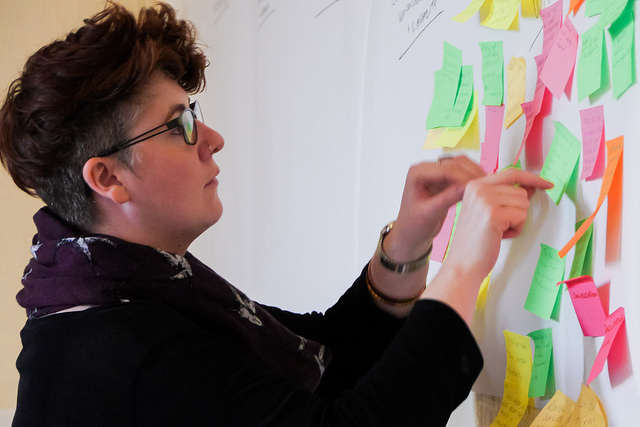After sharing an open call to invite people who would like to work with us on this project we hosted an event designed to focus specifically on ‘collaboration’ and building relationships. On the day approximately 45 people from a range of agencies, groups and organisations were present.
The purpose of the day, as the previous post details, was to meet people, to be clear about the parameters of the work and to model the types of approaches which we know are useful for collaboration. The trick in all this was to provide enough structure, but remain true to principle of collaboration – i.e. to let the work emerge from the connections arising from those in the room. It was clear that:
- the Contribution Analysis (a theory based approach to evaluation) generated the most energy from those in attendance. This process involves the creation of a logica model which presents the links between resources and outputs. On the day, a logic model was collectively designed by the group and presented back for them to use to enlist others back in their places of work/communities.
- We also asked people to address their locality (like a friend) and set out their vision for collaborative working by writing a letter to members of the community. Templates for these letters were given to people to take away – the hope being that they’d encourage others to set out their visions so that similarities and differences could be surfaced at the next event.
The evaluations from the day tell a largely positive story, however there were clearly mixed feelings about the approach being used. Many people were seeking greater clarification – and it was obvious that we needed to do more to explain why we were looking to work with partners to give this work clarity, purpose and to engage with a wider reach of partners. We recognise that some of the ‘unknown’ was tough. Much of this was intentional because we consciously didn’t want to put too many limits on the work. However, in the evaluation comments, there were some key questions which knew it would be important to be much clearer on in the subsequent event.
Rather than reverting back to old ways of working by being directive about the direction we need to take the project in, we’ve been trying to hold these feelings much more lightly, and accept that the purpose of this work (at this stage) is that it is collaboratively designed. To explain exactly what we are going to do doesn’t model the kind of practice we want to engage in. Many of us at Iriss found this challenging, and its no surprise that those who attended might have felt this way too. Although new and difficult, we are also learning a lot about the difficulties of working in a traditionally competitive and closed system, to a collaborative and transparent system of practice.
Photographs and a film of reflections from those who attended is available here
